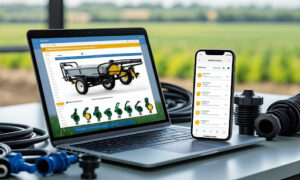Introduction
In the ever-evolving landscape of agriculture, technology has emerged as a driving force, revolutionizing traditional farming practices and catapulting nations into the realm of advanced agricultural prowess. In this blog post, we embark on a journey to explore and unravel the question: Which country boasts the most advanced agriculture technology?
Countries Leading in Advanced Agriculture Technology
The global race for agricultural innovation has intensified over the years, with nations striving to leverage cutting-edge technologies to enhance crop yields, optimize resource utilization, and ensure sustainable agricultural practices. As we delve into the contenders for the title of the most technologically advanced agricultural nation, it becomes evident that several factors contribute to a country’s agricultural dominance.
1. United States
At the forefront of agricultural innovation stands the United States, a powerhouse that has seamlessly integrated technology into its farming landscape. From precision agriculture and drone technology to advanced irrigation systems, American farmers leverage a myriad of technologies to boost productivity and minimize environmental impact.
Precision agriculture, a cornerstone of American agtech, involves the use of satellite imagery, sensors, and GPS technology to monitor and optimize crop conditions. This data-driven approach allows farmers to make informed decisions, leading to increased efficiency and reduced waste.
Moreover, the U.S. has been a trailblazer in the adoption of autonomous machinery, such as self-driving tractors and robotic harvesters. These innovations not only streamline farming operations but also address labor shortages, a persistent challenge faced by the global agricultural sector.
2. Netherlands
Despite its relatively small size, the Netherlands has emerged as a juggernaut in agricultural technology, earning the moniker “Silicon Valley of Agriculture.” The Dutch have mastered the art of controlled environment agriculture (CEA), utilizing greenhouses equipped with state-of-the-art technologies.
In the Netherlands, precision farming is taken to new heights with the integration of smart sensors, climate control systems, and automated nutrient delivery. This meticulous approach ensures optimal growing conditions, enabling year-round production and minimizing the impact of external factors such as adverse weather.
Furthermore, Dutch innovations in vertical farming and aquaponics showcase a commitment to sustainable farming practices. These methods not only conserve space but also reduce water usage, making them crucial components of the future of agriculture.
3. Israel
Facing the challenge of cultivating arid land, Israel has pioneered agricultural technologies that focus on water efficiency and resource conservation. Drip irrigation, developed in Israel, has become a global standard for water-conscious farming. This method delivers water directly to the plant’s roots, minimizing waste and maximizing efficiency.
Israel’s success in transforming barren landscapes into agriculturally productive areas is attributed to advancements in soil management and crop monitoring. The country’s expertise in utilizing satellite technology for precision agriculture allows farmers to monitor crop health, predict diseases, and optimize irrigation schedules.
4. China
China, with its vast agricultural landscape, has embarked on a journey of technological resurgence in agriculture. The country’s commitment to achieving food security and sustainability has led to widespread adoption of precision farming techniques, robotic automation, and biotechnology.
In particular, China has embraced the use of unmanned aerial vehicles (UAVs) for crop monitoring and pesticide application. These drones provide real-time data, allowing farmers to make timely decisions and address issues such as pest infestations swiftly.
Additionally, the integration of artificial intelligence (AI) in agriculture has gained momentum in China. AI-powered systems analyze vast amounts of data to optimize planting patterns, predict crop diseases, and enhance overall farm management.
Key Factors Driving a Nation’s Agricultural Dominance
In the realm of agriculture, certain factors play a pivotal role in determining a country’s dominance in the field. From technological prowess to sustainable practices, these elements collectively shape the agricultural landscape. Let’s delve into the key factors contributing to a nation’s agricultural supremacy.
1. Technological Innovation:
At the forefront of agricultural dominance lies technological innovation. Nations that invest in and adopt cutting-edge technologies, such as precision agriculture, automation, and data-driven decision-making, gain a significant competitive edge. The integration of smart devices, drones, and artificial intelligence enhances efficiency, maximizes yields, and minimizes environmental impact.
2. Research and Development Initiatives:
Countries committed to advancing their agricultural sectors prioritize robust research and development initiatives. Investing in scientific advancements, crop genetics, and sustainable farming practices ensures continuous improvement and resilience against evolving challenges. A strong emphasis on innovation fosters a culture of adaptability, enabling nations to stay ahead in the agricultural race.
3. Infrastructure and Logistics:
A well-developed infrastructure is crucial for the success of any agricultural sector. Efficient transportation networks, storage facilities, and distribution systems ensure that agricultural produce reaches markets promptly and in optimal condition. Nations with a focus on enhancing their agricultural infrastructure pave the way for sustained growth and competitiveness.
4. Education and Training Programs:
A knowledgeable and skilled workforce is an invaluable asset in agriculture. Countries that invest in education and training programs for farmers, agricultural scientists, and technicians create a foundation for success. Empowering individuals with the latest agricultural techniques and best practices fosters innovation and ensures the effective implementation of advanced technologies.
5. Sustainable Agricultural Practices:
Environmental consciousness is increasingly becoming a key factor in determining agricultural dominance. Countries that prioritize sustainable practices, such as organic farming, agroecology, and water-efficient irrigation, not only contribute to global environmental goals but also build a resilient agricultural sector capable of withstanding long-term challenges.
Conclusion
In the global race for the most advanced agriculture technology, several countries have emerged as leaders, each contributing unique innovations to address the complex challenges faced by modern agriculture. From precision farming in the United States to controlled-environment agriculture in the Netherlands and robotic advancements in Japan, the world is witnessing a convergence of technology, sustainability, and efficiency in food production.
As nations continue to invest in research and development, the future holds exciting prospects for the agricultural sector. The synergy between traditional wisdom and technological innovation is paving the way for a more sustainable, resilient, and productive global agricultural landscape. In this interconnected world, the exchange of ideas and collaboration between nations will play a crucial role in shaping the future of agriculture for the benefit of all.



































